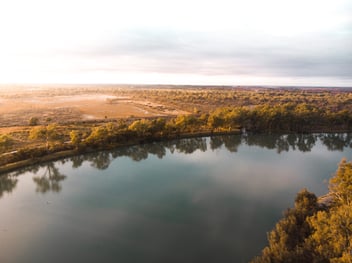National focus needed to protect Great Artesian Basin
It underpins almost $13 billion in economic output annually but the Great Artesian Basin is suffering from fragmented regulation and limited understanding, with leading experts urging for ongoing national support for the resource.
A new Federal Government report has revealed the huge economic yield of industries utilising groundwater from the Great Artesian Basin (GAB), and identified increasing demand as the key challenge to its management.
Flinders University School of Environment Associate Professor Andrew Love said increased use of the groundwater resource will depend on gaining a more thorough understanding of what is an extraordinarily complex and varied groundwater system.
“The GAB is huge and is one of the largest aquifer systems in the world. It underlies about 22% of the Australian continent. The system can be up to three kilometres thick in the central part of the basin and it contains vast quantities of groundwater,” he said.
“The GAB is Australia’s largest groundwater resource with approximately 50% of the groundwater of potable quality. If we took the entire volume of the Murray Darling Basin – both surface water and groundwater – we would need 65 of those volumes to fill the GAB.
“The GAB was originally considered to be a single, continuous groundwater system, with 2000-3000km flow paths from the western edge of the Great Dividing Range in Queensland all the way to SA.
“As time has passed, we have realised that the system is a lot more complicated than that. The classical ‘pipe flow’ model is recharge at one end, discharge at the other. We know it is more than just a simple pipe now, with many inputs and outputs along the way, including interaquifer leakage.
“It is very complex indeed. Much more complex than was previously thought.”
While the resource itself is immense, Love said extraction without recharge can create pressure imbalances, leading to aquifer depletion and related ecological impacts.
“[The GAB] is a fossil resource. It was recharged at a different time to today, particularly the western side of the GAB,” he said.
“Except for one or two isolated spots, where we have had rapid recharge beneath a couple of riverbeds, there is zero recharge today, and there has been zero recharge in the last 10,000 years.
“This means if you are taking out water, you are effectively mining groundwater.”
Love said although this is more of a concern on the western side of the GAB, its eastern side faces issues with dropping pressure due to groundwater extraction.
“Recharge going into the system does not match the discharge coming out. We refer to this as being ‘not in a steady state’; it is trying to reach a new equilibrium. It’s not there yet, and probably never will be,” Love said.
“Pressure is key to managing this system. Water moves slowly, and pressure moves quickly. Pressure is what feeds the springs. So if, for example, you could build a massive mine in the Northern Territory and we could potentially wipe out the Dalhousie Springs located across the border in South Australia.
“While this is a dramatic example, it does illustrate the point that we need to manage the system very carefully.
“There are a lot of different local rules that apply around the country. But there is no unified management system. There is no whole-of-basin management.”
National Centre for Groundwater Research and Training Director Professor Craig Simmons, who will be speaking on groundwater at the NT Water in the Bush Conference, said any successful management plan moving forward will need to continue to take a transboundary, whole-of-basin approach.
He said coordinated cross-jurisdictional administration and securing the necessary ongoing support and resourcing is a key challenge in ongoing efforts to manage the GAB.
“One of the big challenges with transboundary hydrogeology is how to manage aquifers that sit across states and, in many parts of the world, countries, where different regulation, legislation, policy and management frameworks often exist. Coordinating science, management and policy in such situations is a challenge,” Simmons said.
“The GAB sits across four states and territories. It’s not easy to manage a large system spread across multiple states. It’s similar to the Murray-Darling Basin; basin management across states and territories inevitably creates challenges.”
Love agrees, stating that the GAB requires considerable attention considering how vast the resources actually is.
“We need something similar to the Murray-Darling Basin Authority applied to the GAB. It’s got to be a national arrangement and it’s got to have teeth,” Love said.
“We have come a long way in our understanding of the basin hydrogeology but much more needs to be done in terms of understanding the science.
“This is important if we are to strike the balance between supporting industry and ensuring safe, sustainable groundwater pressures and healthy ecosystems that depend on them.”


